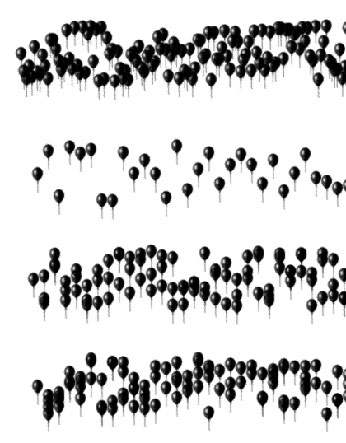Photoshop 7: Using Brush Shapes and Textures

Scattering
Scattering spreads copies of the brush tip as instances along the path of the stroke. The next image illustrates how Spacing affects Scattering and shows the influence of the Count and Count Jitter options.

In this image, the following settings are used:
- Spacing 25%, Scatter 220%, Count 0, Count Jitter 0%.
- Spacing 100%, Scatter 220%, Count 0, Count Jitter 0%.
- Spacing 100%, Scatter 220%, Count 3, Count Jitter 0%.
- Spacing 100%, Scatter 220%, Count 3, Count Jitter 60%.Using Spacing to create a specific density of brush instances results in substantial overlap in places, as well as some areas of “clumping,” where many instances occur in a small space. Using the Scattering and Count options, especially in conjunction with Count Jitter, produces the appearance of random distribution, while doing a better job of preserving individual brush instances.The Scattering pane of the Brushes palette also offers the check box Both Axes. In the first set of examples, only one axis is used for distributing the brush instances. The scattering is perpendicular to the path. Adding the second axis enables you to randomize the scattering along the path as well.

These five examples, all set to Spacing 100%, do not use the Count option in order to better display the effect of adding a second axis of distribution. The settings used in image are:
- No scattering.
- Scatter 100%, one axis.
- Scatter 100%, both axes.
- Scatter 250%, one axis.
- Scatter 250%, both axes.
Enabling the Both Axes option produces a result much like using a reduced Spacing setting — some clumping of the brush instances occurs as the distribution is varied along the path of the stroke.
Tip: When Count and Count Jitter are used and Scatter is set to Both Axes, a very random pattern can be produced, but you’re likely to see brush instances bunched together in groups. Add some Roundness Jitter (Shape Dynamics) to produce an illusion of depth.
This article was last modified on January 3, 2023
This article was first published on June 25, 2002
Commenting is easier and faster when you're logged in!Leave a Reply




make this way to get more information and more knowledge in your life..thanks and enjoy searching…Value our life …
cathy
http://www.pptse.net
M2M Search
Good!